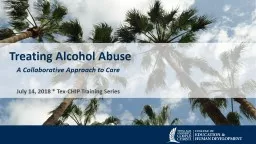

July 14 2018 TexCHIP Training Series Role of Nutrition amp Lifestyle in PreventionManagement of Alcohol Abuse Understanding Provider Role in Treating Alcohol Abuse Registered Dietitians focus is on the ID: 908461
Download Presentation The PPT/PDF document "Treating Alcohol Abuse A Collaborative A..." is the property of its rightful owner. Permission is granted to download and print the materials on this web site for personal, non-commercial use only, and to display it on your personal computer provided you do not modify the materials and that you retain all copyright notices contained in the materials. By downloading content from our website, you accept the terms of this agreement.
Slide1
Treating Alcohol Abuse
A Collaborative Approach to Care
July 14, 2018 * Tex-CHIP Training Series
Slide2Role of Nutrition & Lifestyle in Prevention/Management of Alcohol Abuse
Slide3Understanding Provider Role in Treating Alcohol Abuse
Registered Dietitian’s focus is on the
nutrition diagnosis
rather than medical or psychiatric diagnosis
Nutrition diagnoses are written as a
“PES”
statement which identifies the nutrition
Problem
, it’s
Etiology
,
and the
Signs/ Symptoms
which point to that problem
Example
:
Underweight
related to
inadequate energy intake
as evidenced by
BMI of 14
and
reported intake of <50% of estimated calorie needs
.
Slide4Understanding Provider Role in Treating Alcohol Abuse
Interventions, goals, and evaluation methods are then tailored to the
nutrition diagnosis
Example:
Educated client on estimated calorie needs
Recommended prescription to PCP for oral nutrition supplement once daily to help meet estimated needs
Most PES statements in this population are surrounding
energy balance
,
weight status
and
history
,
hydration status
, and
nutrient deficiencies
Slide5Considerations when Interacting with Clients
Cognitive Considerations:
Impaired cognition makes accuracy or dietary recalls questionable
Be aware of the emotional fragility of client and caregiver
Scope of Practice Considerations:
Redirect conversations to stay within bounds of RD’s Scope of Practice
Home Life Considerations:
Does client have a support system or enablers?
Finances, available tools, & surrounding community play large roles in recovery
Slide6Considerations when Interacting with Clients
Anthropometric Considerations:
Collect information on height, weight, weight history, and Body Mass Index
Review recent and past lab values to identify any areas of concern (i.e. Liver disease, nutrient deficiencies, anemia, etc.)
Conduct a Nutrition-Focused Physical Assessment to help identify malnutrition
Nutrition Considerations:
Collect a 24-hour dietary recall from client and/or caregiver
Include information on vitamin or oral nutrition supplement use
Slide7Our Treatment Plan
Healthcare Domain: Nutrition
Provider:
Dietitian
Objective
:
Decrease in alcohol abuse
as indicated by client report of:
Reduction in
frequency and volume of alcohol consumption as compared to initial assessment and/or last follow-up
Improved nutrition status based on weight maintenance and energy and fluid intake meeting >75% of estimated needs
Compliance with
vitamin and nutrition
supplement orders as
prescribed by PCP and/or RD
Goals
:
Abstaining
from alcohol
Energy and fluid balance by consuming
foods and non-alcoholic beverages
that
provides 90-110% of estimated needs
Micronutrient
deficiencies corrected, particularly so that serum B-vitamin, iron, and potassium levels are within normal limits
Prevent further damage through dietary management as able (i.e. liver disease, hypertension, anemia, etc.)
Interventions
:
Assist
client with revisiting coping strategies to manage triggers of alcohol consumption
Educate client on estimated calorie
and hydration and provide sample culturally-relevant menu plans that meet client’s needs
Recommend and/or order prescriptions for multivitamin and/or oral nutrition supplements
Offer dietary education on management of complications of alcohol abuse as able
Slide8Measuring Outcomes/ Success
Weight maintenance or weight gain without increase in consumption of alcohol-containing beverages Increased reports of energy and fluid intake according to 24-hour diet recall or food journal
Reports of decreased alcohol intake
Patient
compliance with supplement use as
prescribed
Lab values show micronutrient levels improving or within normal limits
Slide9Communication from Counselors
Helps gauge motivation and readiness to changeProvides insight on support system and home life that I may not have received from assessment conversations
Offers
valuable information on progress being made, resources being sought, and emotional and mental state of client
Often times, nutrition status is not top-of-mind for a client seeking or receiving care for alcohol abuse